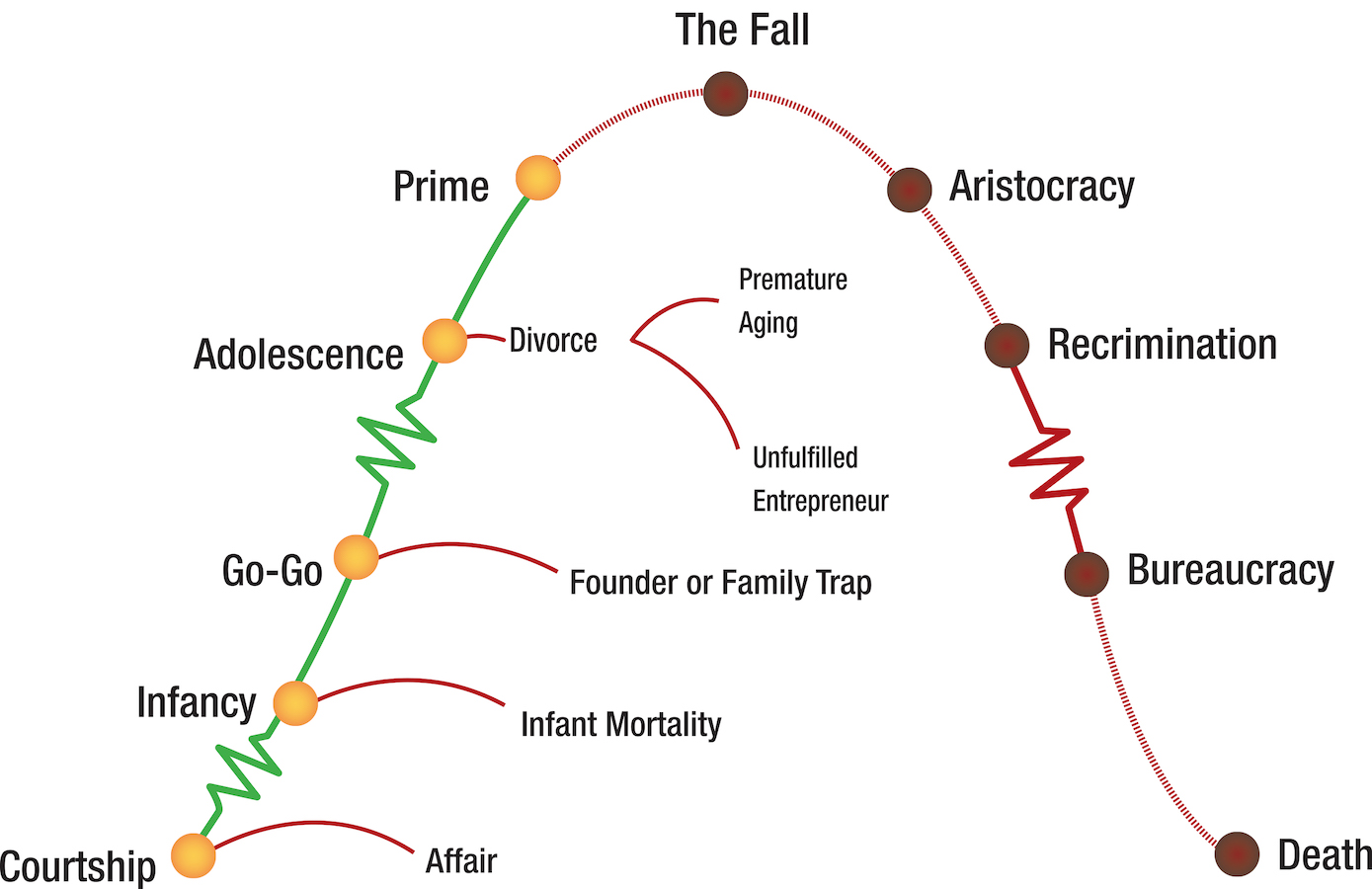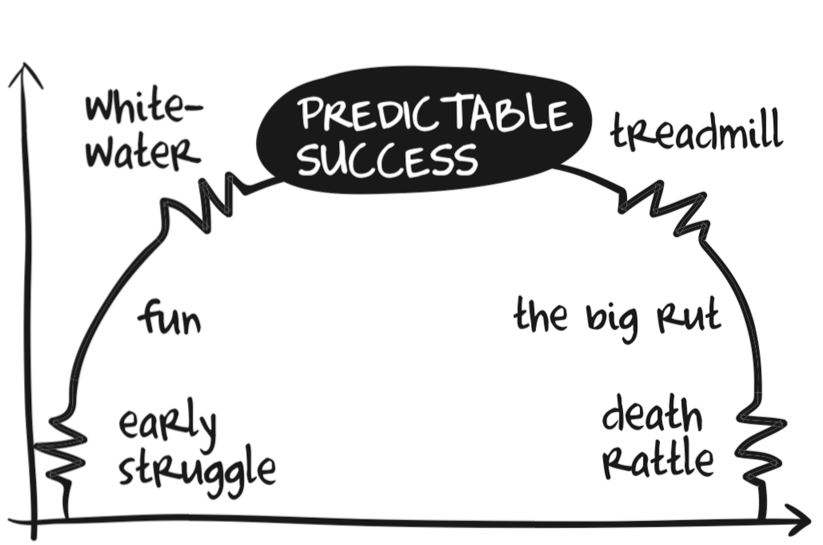How Teams Grow, Thrive, and Fail
As your team or business grows, things change – they have to! A $10 billion business cannot operate the same as a 1-2 person startup. And since no businesses start at that scale, it’s important to understand what helps a team grow without breaking. How can your team continue to innovate, take on new customers, provide quality service, and maintain a healthy work/life balance for your staff?
A key difference between large and small teams is their amount of process and organization. As new problems arise from growth, successful teams adapt. And they do so without losing what made them great to begin with. But as you’ll see, a team can easily cross an imaginary line into bureaucracy. Their processes can become cumbersome, and begin to suck the life out of them. They lose themselves as they keep adding layers of process in order to accomodate for their growth.
The goal of this discussion is to help you understand the different stages of growth, identify where your team is at, and learn how to take on the next stage with confidence. But first we have to talk about … Problems.
Problems
If your team is lucky enough to grow, you’re bound to experience growing pains. What worked for your team when it was small is no longer working. Communication is breaking down, quality has declined.
But guess what? If you can solve the problems that you’re currently facing, you’ll be handsomely rewarded with … new problems! And they won’t be the same ones – they’ll be larger and more complex. So if dealing with growth problems is a constant, what can we do to prepare for them?
Your role is not to prevent problems. Nor is it to slow the pace of change. Instead, your focus should be on increasing your team’s ability to both recognize and resolve problems. One of these is not enough. High recognition with low resolution is chaos. Low recognition with high resolution is a team with its head in the sand. But if your team can do both – quickly recognize and then resolve problems – you have a distinct advantage.
But how can you possibly foresee the future like this? Thankfully, most of the issues you will face are common to other teams. Understanding the different stages of growth will allow you to see the road ahead and prepare for what’s next.
So let’s take a look at what these different stages of growth look like.
LifeCycles
I was first introduced to the idea of “Lifecycles” through the work of Dr. Izach Adizes. His book “Corporate Lifecycles” is well researched and is a wonderful, detailed exploration. His model starts with the “Courtship” phase, progresses through the apex of “Prime”, then descends to “Bureaucracy” and finally “Death”.

The Adizes model is more detailed than the other model we’ll look at and provides several “short-circuit” scenarios like “Affair” and “Founder’s Trap” that explain certain ways where teams can cut their lives short through negative behaviors.
The second model was created by Les McKeown in his book “Predictable Success”. It takes the highly academic work of Adizes and simplifies it greatly. We’ll explore this one in more depth because it provides a good entry-level overview of the concepts.

Early Struggle
“Early Struggle” is your team or business’ first steps into the world. It’s an exciting, yet terrifying time for your team. For a business, the stakeholders are simply focused on two things: cash flow and establishing a market. For a team within an organization, you might have been newly tasked with creating and building a team and feel the need to prove yourself or even prove that your team should exist! Unfortunately, most new businesses never make it out of this stage. But if you’re lucky enough to do so, it’s time for “Fun”!
Fun
Congrats! The frustration and difficulty of “Early Struggle” is behind you. You’ve established a market, you have a few customers, and you’re not so terrified about revenue. Your team has proven itself and you’re quickly transitioning from cash to sales. Things are growing and you’re having a huge impact because you’ve got your hands in everything. You may not how why you’re growing, but it sure is fun!
“Fun” is also where you get company myths. If your team is past this stage, you’ll hear about the “old timers” that came before you. At Heroku, people fondly reminisce of when we crossed $10 million or that major incident where people were all-hands-on-deck. The people on the team that came before me were gods. These myths are built because at the time, these people were part of small team that did incredible things!
Whitewater
Mo’ customers, mo’ problems. In “Whitewater”, you start to notice that the structure and minimal processes you built during “Early Struggle” and “Fun” aren’t fully adept at handling the growth of your business. If you’re on a support team, you’re finding yourself unable to keep up with all the tickets. So you start to hire. But hiring requires training. What about those feature requests and bug reports? How should we organize them and report them back to product or engineering?
You may be able to come up with ways to change things, but are they the right decisions? And you may have good ideas, but getting these new policies to actually stick is an entirely other issue. Your team is having an identity crisis (and you probably are too).
The focus used to be on cash, then sales, but now it’s on profitability. And profitability requires new systems and policies to bring your team towards “Predictable Success”.
Predictable Success
“Predictable Success” is the perfect balance between process and innovation. Predictable Success is healthy and sustainable. Your team is structured and adaptive, but your team is also given the freedom to work efficiently without being bogged down by process. Your team is able to consistently set and achieve their goals.
The big difference between “Fun” and “Predictable Success” is that you actually know how and why your team is growing and are able to adapt to changes in the business.
Treadmill
You might consider “Predictable Success” a perfect balance between your cowboys and your bureaucrats; between your highly innovative and highly organized types. If that’s the case, “Treadmill” is what happens when your bureaucrats begin to have too much say in things. Policies begin to be too burdensome. Your team is spending more time trying to cross every T and dot every I, and as a result, they’re not getting much done.
The metaphor of a treadmill is perfect for this stage because while a lot of energy is being applied, there’s little to no forward momentum. Risk-taking, creative thinking, and initiative are in decline. We’re now in a world where we second guess everything. Why bother taking a risk?
You see where this is going…
The Big Rut
If “Treadmill” is what happens when process begins to squeeze out innovation, “The Big Rut” is what happens when this environment begins to solidify. “Treadmill” can be reversed – processes can be trimmed back and innovation can be restored. But left unchecked, “The Big Rut” takes over. The team now firmly values process and systems over action and results. The team has also lost its self-awareness and can no longer diagnose problems as they come up. “A problem?! Well, is there a playbook to follow?”
Sadly, companies can stay here for a very long while, but eventually they’ll decay.
Death Rattle
If you love bankruptcies and corporate sell-offs, then you’ll love “Death Rattle”! This is the end of the line. People are jumping ship left and right and things are falling apart. If you were lucky enough, you got out of the burning building with only 2nd degree burns. This is a sad stage for any company, but far too common.
Application
Where is your team?
But the good news is, this doesn’t have to be your story! If you’re reading this, chances are your team isn’t in one of the last two stages (by that point, those organizations have lost the self-awareness to read an article like this!). So how can we apply this understanding of these stages to our teams and businesses?
First, it’s crucial to identify your team along this arc. Is your team small and struggling? Mid-size and cruising? Growing beyond your capacity? Second, once you identify what stage you’re in, you can see what it will take to move closer to the next stage and what will be waiting for you when you get there.
Implementing Process
If there is only one thing you remember from this discussion, it should be this: how you decide on and implement systems and processes is crucial to your team’s success. Create too much process and you’ll snuff out innovation and start your team on the path to The Big Rut. Create too little process and your team will buckle under the weight of its own growth and new responsibilities.
When deciding to implement process, remember two things: 1) only implement new processes when necessary. Don’t create a new policy because it’s a Monday and you feel like you haven’t done much work as a manager lately. And similarly 2) don’t create policies for one-off issues. Wait to see if a pattern arises. Nothing is worse as an innovator on your team than to have Mike from accounting screw up everything for the rest of us because the team manager felt like every decision now has to have multiple layers of approval and now things are stupid and suck and I’m going to start interviewing somewhere else tomorrow.
Finally…
We’ve quickly covered the ideas of a team lifecycle. Hopefully, you’re able to identify where your team is at and you’re now able to see what’s behind and ahead of you. And you’re now able to see where this is all headed – towards a “prime” position. Balancing on the tip of this arc, your team has found middle ground between too much and too little process. Innovation is fostered, but is given healthy boundaries that encourage growth. And you’ll be able to see what it looks like when your team begins to tip too far into systems and administration.
“Your people are doing their best, but their efforts cannot compensate for your inadequate, dysfunctional system.” Peter Scholtes, The Leader’s Handbook
Take some time to self-reflect on where your team is and where it’s headed; what challenges await you around the next corner. Doing so will enable your team to attack the problems – instead of each other.
Hi there, I'm Jon.
Writer. Musician. Adventurer. Nerd.
Purveyor of GIFs and dad jokes.